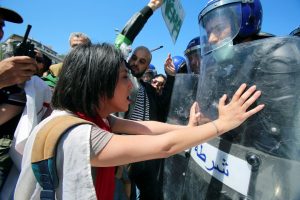
Since the 9/11 attacks, the Arab world’s relative economic, social, and political underdevelopment has been a topic of near-constant international concern. In a landmark 2002 report, the UN Development Program (UNDP) concluded that Arab countries lagged behind much of the world in development indicators such as political freedom, scientific progress, and the rights of women. Under U.S. President George W. Bush, this analysis helped drive the “freedom agenda,” which aimed to democratize the Middle East—by force if necessary—in order to eradicate the underdevelopment and authoritarianism that some officials in Washington believed were the root causes of terrorism. Bush’s successor, Barack Obama, criticized one of the cornerstones of the freedom agenda—the U.S. invasion of Iraq in 2003—but he shared Bush’s diagnosis. In his first major foreign policy speech as president, delivered in Cairo in 2009, Obama called on Middle Eastern governments to make progress in democracy, religious freedom, gender equality, and “economic development and opportunity.” Implicit in his remarks was a widely shared view among Western observers of the Middle East: that the Arab world’s dysfunction was a product of social and political arrangements that thwarted human potential, furthered inequality, and favored a small elite to the detriment of the broader population.
During the first decade of this century, progress was slow. Under the surface, however, discontent was rising. This discontent culminated in the protests of 2010–11, commonly known as the Arab Spring. In countries as diverse as Egypt, Libya, Syria, and Tunisia, ordinary citizens took to the streets to challenge their authoritarian rulers and demand dignity, equality, and social justice. For a moment, it seemed as if change had finally arrived in the Middle East.
The situation in the Middle East looks even worse than it did before the Arab Spring.
Yet in the aftermath of the Arab Spring, development stalled. Although some countries, such as Tunisia, were able to consolidate democratic systems, authoritarian leaders in much of the region successfully counterattacked. In Egypt, the military led a coup in 2013 to depose the democratically elected government; in Libya and Syria, dictators responded to peaceful protests with violence, precipitating brutal civil wars that turned into international proxy conflicts. Even in countries that did not descend into violence, autocrats clamped down on dissent and poured resources into suppressing their own people and undermining democratic transitions across the Middle East. Meanwhile, progress on the human development indicators prioritized by both international experts and U.S. policymakers either stagnated or went into reverse.
Today, nearly ten years later, the situation in the Middle East looks even worse than it did before the Arab Spring. Political repression is more onerous. Economic growth is sluggish and unequal. Corruption remains rampant. Gender equality is more aspiration than reality.
Yet something fundamental has changed. Arab governments have traditionally rested on what political scientists call an “authoritarian bargain,” in which the state provides jobs, security, and services in exchange for political loyalty. This bargain is based on the assumption that ordinary people will remain passive. But today, that assumption no longer holds. Citizens no longer fear their governments. Now more than ever before, ordinary people across the Middle East are politically engaged and willing to voice dissent. And as the massive protest movements in Algeria and Sudan earlier this year showed, they remain willing to take to the streets to demand a better future, even in the face of repression. The Arab Spring may not have ushered in the immediate reforms that many had hoped for, but in the long run, it may have accomplished something more important: awakening the political energies of the Arab world and setting in motion the long process of Arab revitalization.
